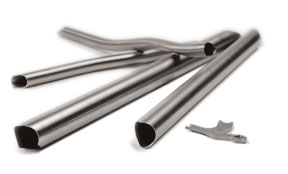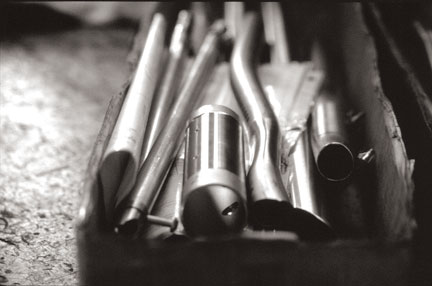Titanium Production

Titanium is available all over the world, although many people believe that the element titanium is extremely rare. Actually, it is the earth's fourth most abundant metallic element. Only aluminum, magnesium, and iron are more plentiful.Nonetheless, titanium is never found in its pure form in the environment. Instead, the metal must be extracted from other compounds, such as rutile ore and ilmenite.
This extraction process is difficult and expensive, and is one of the reasons why titanium, and therefore titanium tubing, is so costly. The first step in the purification process is to create titanium sponge, named for its sponge-like appearance. Titanium dioxide-which also happens to be found in all kinds of white substances like paint, M&M candy prints, and donut fillings-is first mixed with coke; the mixture is then charged in a chlorinator. Titanium tetrachloride-or "tickle"-results when the ore reacts with the chlorine.
The tickle, a colorless liquid, is purified through fractional distillation then mixed with powdered magnesium. The brew is placed in a sealed container, void of oxygen and hydrogen, and heated up until the magnesium has reacted with the chlorine.
This produces magnesium chloride and sought-after deposits of pure titanium, known as titanium sponge. The sponge is compressed by enormous hydraulic presses into large pieces of titanium, referred to as compacts. The compacts are then TIG-welded together, end to end, to form a consumable electrode, weighing more than 25,000 lbs.
The pure titanium is alloyed at this stage, as well. 3Al-2.5V titanium, the material from which most titanium frames are manufactured, is created by adding 3% aluminum and 2.5% vanadium to the titanium.
The electrode, which is about one meter in diameter, is placed in a consumable electrode vacuum arc furnace to create a molten pool of titanium. Then, it is allowed to solidify in the furnace. The furnace has a copper lining for protection from the titanium, but because the copper lining of the furnace becomes attached to the titanium when frozen, it is removed along with the titanium.
Using a large lathe, the copper is then separated from the ingot. The titanium is now steps away from becoming tubing. But before it does, the ingot is reduced by an oversized forge. This forge is specifically designed for titanium, since titanium can't be forged in the presence of oxygen. While in the forge, the ingot is continuously hammered and annealed. Annealing is the process of heating and cooling at a controlled rate, and is used for many purposes, including removing work hardening and embrittlement. The process is repeated until the ingot becomes a bar measuring approximately 8" in diameter, the proper size to fit through the hole of the impact extrusion machine. The impact extrusion machine (actually a combination of a forge and an extrusion machine) is used to make bar stock into tubing.
Manufacturing Titanium Tubing
The fabrication of titanium tubing requires special equipment and an oxygen-free environment. Depending upon how stringent the specifications for the tubing's size and weight, purity, straightness, molecular grain orientation, surface finish, and the presence or lack of surface defects, titanium tubing can cost nearly $60 per foot.

The 8" titanium bar that is created from hammering and annealing during the manufacture of titanium is at last fed into an impact extrusion machine. An enormous hydraulic cylinder drives the bar into one end of the machine to create an extremely hot tube, measuring approximately 45' in length. The tube is immediately immersed in a tub of hydrochloric acid to remove its superfluous outer layer. The machine draws the oversized tubes down in size to create a tube hollow. But the tubing still isn't in a usable form. The tube hollow is shipped to a tubing mill, where the titanium is transformed into tubing. When the tube hollow arrives at the mill, it is weighed and inspected both visually and dimensionally. The hollow is also subjected to a chemical analysis to verify that the tube meets the mill's certification for purity requirements. Once the tube passes those tests, the hollow is cleaned and pickled (acid etched) to remove any oxidization or residual scale (also known as alpha case) and is ready for vacuum annealing.
Vacuum annealing - is a critical step in the manufacture of titanium tubing for two important reasons: It lowers the strength of the tube to prepare it for the pilger mill (rocking). Titanium work hardens; thus, when the tube is run through the pilger mill, the tube's strength increases dramatically. As a result, the titanium becomes much harder and tougher and would damage the pilger were it not first vacuum annealed. It makes the tube malleable (relieves stress) so that it can run through the pilger mill. This dramatically increases the tube's ductility without causing it to further lose strength. Were the tube not ductile, it would be very brittle and more likely to fail. It would also be much more difficult to machine and bend. Since the stress reduction that occurs during annealing can also cause the tube to bend or bow, the tube is straightened before continuing through the process. Pickled once again, the tube is then tested ultrasonically to detect any flaws—chemical or otherwise—that could create a problem during pilgering. The pilger mill consists of an internal mandrel that supports the inside of the tube, and large rollers through which the tube rolls. During rocking, the hollow is squeezed, rolled, and hammered to reduce the diameter of the tube and make the tube wall thinner. The tube is actually pilgered several times. Some passes through the pilger mill focus on reducing the tube's diameter, while others emphasize reduction of the tube's wall thickness. The repeated pilgering is performed as part of a sequence that also includes pickling, annealing, straightening, and ultrasonic testing, until the proper tube size and grain structure are achieved.
Grain structure - is determined by the ratio of the rate at which the tube's diameter is reduced to the rate of reduction of the wall. Grain, or texture, is tested by measuring the contractile strain ratio (CSR) of the tube. A CSR from 1.7 to 1.9 promotes the highest fatigue strength possible, while maintaining excellent bending characteristics. A CSR above 2.0 improves bending, but decreases fatigue endurance dramatically. Since optimal CSR is controlled and determined at the mill, cold working (i.e., tapering or internal butting) the titanium tubing after it leaves the mill can detrimentally affect the endurance of the tube. Once the optimal wall, diameter, and grain structure have been achieved, the tube is pickled again to remove any scale or debris from the pilgering process. A final anneal to accomplish a partial stress relief follows this step. The mill's goal is to achieve a delicate balance of ductility and strength; thus, this round of annealing slightly reduces the strength of the tube, while making it more workable for the end user. One last acid etching of both the inside and outside of the tube follows, since vacuum annealing can leave oxidation or alpha case. This final pickle also imparts a perfect finish. While this is not standard for sports grade titanium tubing, Seven specifically requests this final finish on its titanium tubing. Before the tubing can be boxed up and shipped out, it goes through a series of rigorous tests: eddy current or ultrasonic testing; visual and dimensional inspection; and a final quality control certification.
Titanium Quality
The quality and strength of titanium tubing varies just as it does for steel tubing, depending upon the source of the material. The key to tubing quality lies in processing, which plays a critical role in determining the structural integrity—and therefore the longevity—of the final product. During processing, three variables affect the final quality of a titanium tube: texture, also known as molecular grain orientation; interior and exterior surface finish; and the presence or lack of surface and chemical defects. The tube's texture must be optimized to obtain the highest fatigue strength possible. Similarly, a smooth, defect-free surface also contributes to longer fatigue life. Types of Titanium
In addition to unalloyed titanium, which is called commercially pure or CP, there are two alloys commonly used in the cycling industry today: 3AL-2.5V and 6AL-4V.
3AL-2.5V
3-2.5 Titanium - is an alloy consisting of 3% aluminum, 2.5% vanadium, and 94.5% pure titanium. The properties critical to bicycle tubing are best served by a high quality 3-2.5 seamless tube. Excellent fatigue life, property consistency, form-ability, and corrosion resistance are but a few of the reasons 3-2.5 is still the premier frame material. In the U.S., bicycle frames are commonly manufactured using 3-2.5 certified to either an ASTM B-338 or a sports grade specification. ASTM B-338 meets all Aerospace Material Specifications for hydraulic tubing. Sports grade, certified according to a less stringent set of chemical and mechanical specifications, is typically less expensive. Some builders may use surplus material or "scrap", which meets neither aerospace nor sports grade specifications. Certification is not available for scrap, making it impossible to determine whether the material is of inferior quality.
6AL-4V
An alloy of 6% aluminum, 4% vanadium, and 90% titanium, 6-4 titanium offers some very favorable raw material properties, which is why Seven uses it to fabricate dropouts and other frame parts. One of the properties that makes 6-4 an optimal material for dropouts is its toughness. But this toughness also makes it unattractive as a material from which to make tubing. Applying the techniques used to draw 3-2.5 tubing to 6-4 tubing costs much more and wears tooling very quickly. In addition, tube wall consistency, concentricity, and finish quality—both inside and outside—are limited. At the time of this printing, no U.S. mill offers seamless 6-4 tubing. However, some do offer 6-4 seamed, or welded, tubing. Applying the techniques used to draw 3-2.5 tubing to 6-4 tubing costs much more and wears tooling very quickly. In addition, tube wall consistency, concentricity, and finish quality—both inside and outside—are limited. Two major issues prevent Seven Cycles from favoring this method of tube manufacture. First, seamed tubing is fabricated by rolling 6-4 sheet into a tube shape while simultaneously welding the seam that is created in the rolling process. The result is a tube that has a welded seam—a potential failure point—along its length. This seam acts as both a hard point and a stress riser since the weld bead is thicker than the tube itself and the weld creates an inconsistency in the tube. Second, 6-4 sheet is designed to be used as a sheet, not as a tube. If it is formed into a tube, its grain structure can lead to premature tube failure. Indeed, a 6-4 tube will fail through fatigue cycling (repeated flexing) before it should, and independent fatigue tests show that tubing made from 6-4 sheet does not have the fatigue life of a properly drawn 3-2.5 tube. In recent years, some seamless 6-4 tubing has trickled into the bike industry from outside the U.S. However, it is only being offered as a few internally-butted tube lengths of limited sizes (as determined by tube diameter, wall thickness, and butting placement). These limited offerings are inadequate for modern high-end bike building, which requires a very wide variety of tubing to ensure optimum ride characteristics. In addition, external butting is preferred to internal butting for the reasons outlined in the Tube Butting Processes section of this document, under Manufacturing Overview. One might argue that the strategic use of the limited 6-4 tube sizes available in combination with 3-2.5 tubes would create a better bike. But there is no weight advantage for bikes currently employing 6-4 tubes over the top-of-the-line 3-2.5 bikes available. And there is no appreciable stiffness or strength benefit either, since 6-4's higher bending stiffness is offset by its lower torsional stiffness, and the butting techniques employed in the 6-4 tubes currently available have a negative impact on fatigue strength. So, 6-4 only adds expense.
CP
A small number of titanium frame builders incorporate Commercially Pure (CP) titanium into their frames. CP has, at best, half the strength of 3-2.5. A CP frame must be made heavier than an equivalent 3-2.5 frame in order to have comparable strength. Even most steels used in high quality frames have higher strength than CP. The overall quality of CP tubing is lower because it is typically used in low-cost applications—not bicycle building. CP is used mainly in industrial applications when corrosion resistance is most important.
Tough to Beat 3-2.5
Historically, aerospace and defense industries have driven materials technology, and 3-2.5 continues to be the Ti alloy of choice. At present, these industries are not clamoring for 6-4 tubing, which is why no U.S. mill is producing it. For there to one day be an ample supply of 6-4 tubing in a wide array of sizes and at a reasonable price, it will take the interest and purchasing power of an industry much bigger than the bike business. Though this may be on the horizon, there's no indication that it will happen any time soon. In addition, an examination of some other high-tech industries that depend on high strength alloys like 3-2.5 and 6-4 reveals that none use 6-4 small diameter tubing, primarily for the reasons mentioned above. Consultation with titanium mills tells us that commercially available seamless 6-4 in a variety of sizes is not on the near horizon.

